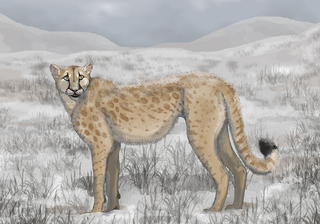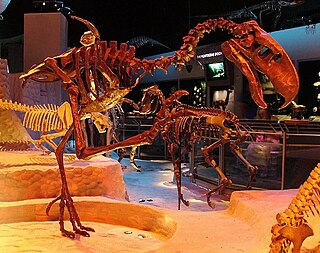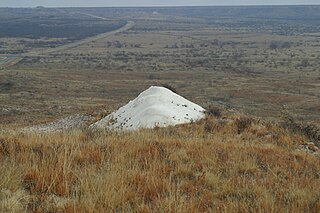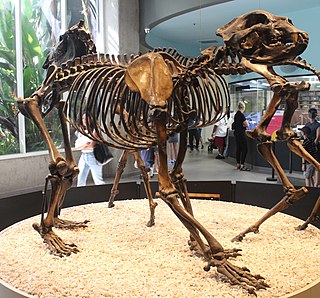Related Research Articles

Miracinonyx is an extinct genus of felids belonging to the subfamily Felinae that was endemic to North America from the Pleistocene epoch and morphologically similar to the modern cheetah, although its apparent similar ecological niches have been considered questionable due to anatomical morphologies of the former that would have crippled any ability to run as fast. The genus was originally known from fragments of skeletons, but nearly complete skeletons have been recovered from Natural Trap Cave in northern Wyoming.

Castoroides, or giant beaver, is an extinct genus of enormous, bear-sized beavers that lived in North America during the Pleistocene. Two species are currently recognized, C. dilophidus in the Southeastern United States and C. ohioensis in most of North America. C. leiseyorum was previously described from the Irvingtonian age but is now regarded as an invalid name. All specimens previously described as C. leiseyorum are considered to belong to C. dilophidus.

Megalonyx is an extinct genus of ground sloths of the family Megalonychidae, native to North America. It evolved during the Pliocene Epoch and became extinct during the Quaternary extinction event at the end of the Late Pleistocene-Early Holocene, living from ~5 million to ~13,000 years ago. The type species, M. jeffersonii, the youngest and largest known species, measured about 3 meters (9.8 ft) in length and weighed up to 1,000 kilograms (2,200 lb).

Glyptotherium is a genus of glyptodont in the family Chlamyphoridae that lived from the Early Pliocene, about 4.9 million years ago, to the Early Holocene, around 7,000 years ago. It had a wide distribution, living in the United States, Mexico, Guatemala, Costa Rica, Honduras, El Salvador, Panama, Venezuela, and Brazil. The genus was first described in 1903 by American paleontologist Henry Fairfield Osborn with the type species being, G. texanum, based on fossils that had been found in the Pliocene Blancan Beds in Llano Estacado, Texas, USA. Glyptotherium fossils have since been unearthed from many more fossil sites, from Florida to Colombia. Another species, G. cylindricum, was named in 1912 by fossil hunter Barnum Brown on the basis of a partial skeleton that had been unearthed from the Pleistocene deposits in Jalisco, Mexico. The two species differ in several aspects, including age, with G. texanum being from the older Early Pliocene to Early Pleistocene strata, whereas G. cylindricum is exclusive to the Late Pleistocene and Early Holocene.

Titanis is a genus of phorusrhacid, an extinct family of large, predatory birds, in the order Cariamiformes that inhabited the United States during the Pliocene and earliest Pleistocene. The first fossils were unearthed by amateur archaeologists Benjamin Waller and Robert Allen from the Santa Fe River in Florida and were named Titanis walleri by ornithologist Pierce Brodkorb in 1963, the species name honoring Waller. The holotype material is fragmentary, consisting of only an incomplete right tarsometatarsus and phalanx, but comes from one of the largest phorusrhacid individuals known. In the years following the description, many more isolated elements have been unearthed from sites from other areas of Florida, Texas, and California. It was classified in the subfamily Phorusrhacinae, which includes some of the last and largest phorusrhacids like Devincenzia and Kelenken.

Bison antiquus, the antique bison or ancient bison, is an extinct species of bison that lived in Late Pleistocene North America until around 10,000 years ago. It was one of the most common large herbivores on the North American continent during the late Pleistocene, and is a direct ancestor of the living American bison along with Bison occidentalis.

Bison latifrons, also known as the giant bison or long-horned bison, is an extinct species of bison that lived in North America during the Pleistocene epoch ranging from Alaska to Mexico. It was the largest and heaviest bovid ever to live in North America. It thrived in North America for about 200,000 years, but became extinct some 20,000–30,000 years ago, at the beginning of the last glacial maximum.

Armbruster's wolf is an extinct species that was endemic to North America and lived during the Irvingtonian stage of the Pleistocene epoch, spanning from 1.9 Mya—250,000 years BP. It is notable because it is proposed as the ancestor of one of the most famous prehistoric carnivores in North America, the dire wolf, which replaced it.

Tremarctos floridanus, occasionally called the Florida spectacled bear, Florida cave bear, or rarely Florida short-faced bear, is an extinct species of bear in the family Ursidae, subfamily Tremarctinae. T. floridanus was widespread in the Southeastern United States during the Rancholabrean epoch, with scattered reports of fossils from other parts of North America and from earlier epochs.

Mount Blanco is a small white hill — an erosional remnant — located on the eastern border of the Llano Estacado within Blanco Canyon in Crosby County, Texas. With Blanco Canyon, it is the type locality of the Blanco Formation of Texas and Kansas, as well as the Blancan fauna, which occurs throughout North America. Mount Blanco is a Late Blancan age site, and is associated with other Late Blancan sites from Texas such as Red Light and Hudspeth local faunas from Hudspeth County, and the Cita Canyon fauna from Randall County.

Port Kennedy was an industrial village located where U.S. Route 422 now crosses the Schuylkill River in Upper Merion Township, Montgomery County, Pennsylvania, United States.

Arctodus is an extinct genus of short-faced bear that inhabited North America during the Pleistocene. There are two recognized species: the lesser short-faced bear and the giant short-faced bear. Both species are relatively rare in the fossil record. A. pristinus was largely restricted to the Early Pleistocene of the eastern United States, whereas A. simus had a broader range, with most finds being from the Late Pleistocene of the United States, Mexico and Canada. A. simus evolved from A. pristinus, but both species likely overlapped in the Middle Pleistocene. Of these species, A. simus was larger, is known from more complete remains, and is considered one of the most charismatic of North America's megafauna.
The Irvingtonian North American Land Mammal Age on the geologic timescale is the North American faunal stage according to the North American Land Mammal Ages chronology (NALMA), spanning from 1.9 million – 250,000 years BP. Named after an assemblage of fossils from the Irvington District of Fremont, California, the Irvingtonian is usually considered to overlap the Lower Pleistocene and Middle Pleistocene epochs. The Irvingtonian is preceded by the Blancan and followed by the Rancholabrean NALMA stages.
The Rancholabrean North American Land Mammal Age on the geologic timescale is the North American faunal stage according to the North American Land Mammal Ages chronology (NALMA), typically set from less than 240,000 years to 11,000 years BP, a period of 0.229 million years. Named after the famed Rancho La Brea fossil site in Los Angeles, California, the Rancholabrean is characterized by the presence of the genus Bison in a Pleistocene context, often in association with other extinct Pleistocene forms such as Mammuthus. The age is usually considered to overlap the late Middle Pleistocene and Late Pleistocene epochs. The Rancholabrean is preceded by the Irvingtonian NALMA stage, and it is succeeded by the Santarosean age.

Canis edwardii, also known as Edward's wolf, is an extinct species of wolf in the genus Canis which was endemic to North America three million years ago from the Late Blancan stage of the Pliocene epoch and was extinct by the end of the Irvingtonian stage of the Pleistocene epoch.
Charles Moore Wheatley was an American miner and palaeontologist of the 19th century. He is noted for identifying several new fossilized species, some of which bear his name, and for his connection to the Port Kennedy Bone Cave, which contained one of the most important middle Pleistocene fossil deposits in North America. In 1879, he was elected as a member to the American Philosophical Society.
The Manix Formation is a geologic formation in California. This formation dates to the Pleistocene Epoch and is know to preserve fossils. Specimens of the extinct camelid, Camelops have been uncovered from the Rancholabrean units of this formation of both the species C. hesternus and C. minidokae.

Capromeryx was a genus of dwarf pronghorns (Antilocapridae) that originated in North America during the Pliocene about 5 million years ago. The closest living relative and only surviving member of the family is the North American pronghorn.

Panthera balamoides is a species described as an extinct species of the big cat genus Panthera that is known from a single fossil found in a Late Pleistocene age cenote in the Yucatan Peninsula, Mexico. P. balamoides has only a single reported specimen, the distal end of a right humerus, that is notably of exceptional size for a felid. It was unearthed in 2012 from an underwater cave and described in 2019 by an international group of paleontologists from Mexico and Germany led by Sarah R. Stinnesbeck. However, several authors have since proposed that the fossil comes from an ursid, possibly the extinct Arctotherium, and not of felid affinities.
References
- ↑ Circa-1894 photo of the entrance to the Bone Cave Archived 2017-06-28 at the Wayback Machine , from Bucks County Historical Society.
- ↑ Bechtel, Timothy D.; Jaime L. Hojdila; Samuel H. Baughman II; Toni DeMayo; Edward Doheny (2005). "Relost and refound: Detection of a paleontologically, historically, cinematically(?), and environmentally important solution feature in the carbonate belt of southeastern Pennsylvania" . The Leading Edge. 24 (5): 537. doi:10.1190/1.1926813. ISSN 1070-485X.
- ↑ "PORT KENNEDY BONE CAVE MONTGOMERY COUNTY" (PDF). DCNR. Commonwealth of Pennsylvania. Archived from the original (PDF) on March 3, 2016. Retrieved 23 December 2014.
- ↑ Cope, Edw. D. (1895). "The Fossil Vertebrata from the Fissure at Port Kennedy, Pa". Proceedings of the Academy of Natural Sciences of Philadelphia. 47: 446–450. ISSN 0097-3157. JSTOR 4061990.
- ↑ Hall, E. R. (1936). Mustelid Mammals from the Pleistocene of North America: With Systematic Notes on Some Recent Members of the Gerera Mustela, Taxidea and Mephitis.
- 1 2 3 4 5 Daeschler, E., Spamer, E. E., & Parris, D. C. (1993). Review and new data on the Port Kennedy local fauna and flora (Late Irvingtonian), Valley Forge National Historical Park, Montgomery County, Pennsylvania. The Mosasaur, 5, 23-41.
- 1 2 Cassiliano, Michael L. (1999-03-15). "Biostratigraphy of Blancan and Irvingtonian mammals in the Fish Creek-Vallecito section, southern California, and a review of the Blancan–Irvingtonian boundary". Journal of Vertebrate Paleontology. 19 (1): 169–186. doi:10.1080/02724634.1999.10011131. ISSN 0272-4634.
- ↑ Parris, David C.; Daeschler, Edward (1995). "Pleistocene turtles of Port Kennedy Cave (late Irvingtonian), Montgomery County, Pennsylvania". Journal of Paleontology. 69 (3): 563–568. doi:10.1017/S0022336000034934. ISSN 0022-3360. S2CID 132442762.
- ↑ Schubert, B. W., Hulbert Jr, R. C., MacFadden, B. J., Searle, M., & Searle, S. (2010). Giant short-faced bears (Arctodus simus) in Pleistocene Florida USA, a substantial range extension. Journal of Paleontology, 84(1), 79-87.
- ↑ Christiansen, Per; Harris, John M. (2005). "Body size of Smilodon (Mammalia: Felidae)". Journal of Morphology. 266 (3): 369–384. doi:10.1002/jmor.10384. ISSN 0362-2525. PMID 16235255. S2CID 27233870.
- 1 2 Horn, George H. (1874). "Notes on Some Coleopterous Remains from the Bone Cave at Port Kennedy, Penna". Transactions of the American Entomological Society. 5: 241–245. doi:10.2307/25076311. ISSN 0886-1145. JSTOR 25076311.